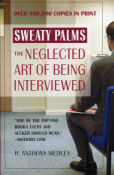| What REALLY goes on in a job interview? Find out in the new revision of "Sweaty Palms: The Neglected Art of Being Interviewed" (Warner Books) by Tony Medley, updated for the world of the Internet . Over 500,000 copies in print and the only book on the job interview written by an experienced interviewer, one who has conducted thousands of interviews. This is the truth, not the ivory tower speculations of those who write but have no actual experience. "One of the top five books every job seeker should read," says Hotjobs.com. | |
| The New World (2/10) by Tony Medley It would have been a daunting task, but director Terence Malick was definitely the man for it; filming the known years of Pocahantasís life, 1607-1616, in real time. Since no one would be willing to sit in a theater for nine years, Malick had the solution; a 2 Ĺ hour film that only makes you feel as if you have sat in the theater for nine years. Malick is the guy who remade The Thin Red Line (1998) concentrating on long, lingering head shots of soldiers thinking while bullets are whizzing by and bombs are exploding all around. He surmounted his Pocahontas task by having virtually no dialogue. He still shows Pocahontas (Qíorianka Kilcher) and Captain John Smith (Colin Farrell) thinking most of the time, but he compounds this by making the audience listen to them thinking. This is a movie that is mostly narrated by voice-overs of the characters telling us what they are thinking while we are watching them think. Thatís bad enough, but probably the worst part of the movie is the maudlin music. The Indians lived in nature and the English settlers lived in a fort in mostly squalid weather. Surviving nature was tough, but they did it. However, how they survived the music that was apparently constantly wafting through the breeze was truly Herculean. My impression of Pocahontas has always been of a dazzling girl of beauty and a sparkling, irrepressible personality. She was one of 129 children of her father and was clearly his favorite. Two explanations as to why she was his favorite are that she was beautiful and charming. But Malick pictures her as unattractive, quiet, and morose, nothing like what she probably was and had to be to accomplish what she did. She was, after all, a 13-year-old in 1607 when she saved John Smithís life and became an intermediary between the settlers and her fatherís tribe of Indians. Having never before seen these strangers, she quickly learned their language and kept the two sides from annihilating each other. She was one of the exceptional women of history. But you wouldnít know it from Malickís interpretation. The only good thing about this movie is how it recreates life in early 17th Century Virginia. Filmed in the actual locale, this probably is pretty close to the way it was, at least as far as the settlers of Jamestown are concerned. Itís too bad such a lovingly faithful recreation is wasted on such a dismal movie. Malick must have blown his budget hiring Farrell, because the rest of the cast is hardly from the A-List. Well, thatís except for Christopher Plummer, who gets second billing. But, then, this is the year that Christopher is going for the Jude Law Award for appearing in virtually every film made during the year. Even so, he is in this one so little that his appearance barely qualifies as anything more than a cameo. If Malick gets to Pocahontasís Happy Hunting Ground (and after this film thatís debatable; making such a tedious movie out of such a wonderful story should be a mortal sin, if not a felony), heís going to owe her a huge apology. December 10, 2005
|
|
|
|
|
